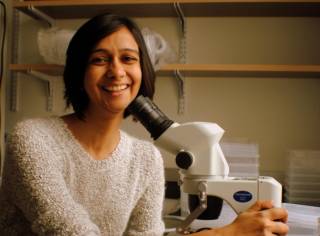Current Projects
Reem Abouward: Investigating mRNA transport granule composition and transport dynamics in motor neurons

Neurons transport messenger RNA (mRNA) over long distances within RNA transport granules, which are made of one or more mRNAs coated by RNA binding proteins (RBPs). It is thought that such granules bind directly to motor proteins for transport, however, recent studies show that they can ‘hitchhike’ onto intracellular organelles for indirect mobilisation. The overall goal of my PhD is to uncover how these two distinct pathways are integrated to ensure coordinated transport along neuronal axons. Moreover, I will determine how these pathways are affected in motor neuron disease (MND). Specifically, I will focus on the RBP named Staufen, which is an important component for RNA granule assembly and transport, and which has been suggested to contribute to MND onset and progression.
I aim to identify the mRNAs transported via either route under normal conditions and in MND. I will use a proximity labelling approach, known as proximity-iCLIP, in which proteins representing each transport pathway are modified by an enzyme that “tags” nearby proteins. Tagged proteins and associated mRNAs can thus be identified and used to investigate RNA granule composition associated with each transport pathway in healthy and diseased neurons.
Ioana Butnaru: Identify critical regulators of tau release and re-uptake, and determining modifiers of these processes acting on key pharmacological nodes

The main aim of my project is to identify new targets involved in tau release for possible therapeutic intervention, with the goal to prevent or decrease pathological tau spreading in AD. For identifying these novel targets, we will characterise the membrane compartments involved in pathological tau release from rodent and human Alzheimer’s Disease (AD) synapses, and test pharmacological modulators of this process. These new findings will be pivotal for the identification of new effective therapeutic targets modulating the release of pathological tau, which are in turn necessary for significantly slowing down AD and related tauopathies.
Samantha De La-Rocque: Characterization of Interneuronal Transfer of Tau

Group Project: Investigating the physiological role of nidogens
Nidogens are a family of basement membrane proteins with binding affinities for other key members of the extracellular matrix such as laminin, collagen IV and perlecan. They are currently believed to have a role in maintaining the structural integrity of the basement membrane. However, previous work in our lab identified a critical role for nidogens in binding of tetanus neurotoxin (TeNT) to the neuromuscular junction and its uptake into motor neurons (Bercsenyi et al., 2014). To continue with this work, a number of lab members are collaborating to investigate the receptor complex components, its transport dynamics and ultimately, the physiological role of internalised nidogen.
Oscar Marcelo Lazo: Mechanisms of assembly and sorting of retrograde signalling endosomes in hippocampal neurons

The ability of neurones to work as individual units, regardless of their extremely polarised and complex morphology, is a consequence of the tightly regulated communication between their different domains. I am interested in the neurotrophic signalling initiated at the axon terminal and retrogradely propagated towards the soma, where it regulates survival, functional identity and morphology of neurones, and it has been proven to be crucial in the pathogenesis of several neurological diseases.
My current project aims to understand how specific GTPases of the Rab family allow a mutual regulation between signalling and endosomal trafficking of TrkB receptors. More specifically, how TrkB signalling pathways regulate Rab10 for coordinating the assembly and sorting of signalling endosomes to retrograde axonal transport. Given that many neurodegenerative diseases show alterations in axonal transport and neurotrophic signalling and the fact that Rab10 has been recently shown to be an important factor in Alzheimer’s disease, this project has the potential to identify novel therapeutic targets for dementia.
Edoardo Moretto: Dissecting axonal transport deficit in tauopathies and its targeting as possible therapeutic strategy

Tauopathies, such as Alzheimer’s Disease and Frontotemporal Dementia, are neurodegenerative diseases in which aggregation of toxic forms of the protein tau is observed leading to neuronal death and subsequently to dementia symptoms. Tau is a fundamental protein that binds microtubules and regulates motor proteins thus playing a crucial role in the regulation of axonal transport. Previous findings have shown that defects in axonal transport precede neuronal death in these and other neurodegenerative disease. However, a detailed analysis of these defects is lacking.
The aim of my UK-DRI funded postdoc is to characterize, by live imaging techniques, axonal transport deficits in vitro and in vivo in animal models of tauopathy as early pre-symptomatic signs of the pathology.
Previous work from our lab has identified different molecules enhancing axonal transport and we will test whether restoring physiological transport in tauopathy animal models before the onset of pathological symptoms could have beneficial effects modifying the progression of the pathology thus paving the way to novel therapeutic agents.
Sergey Novoselov: Studying the tetanus toxin receptor complex by BioID approach

The BioID method exploits the property of the biotin ligase BirA to biotinylate proteins within a 10-nm radius. Fusion of BirA to an atoxic fragment of the TeNT (HcT) enables us to tag proteins coming into close contact with HcT during its recognition, internalisation and retrograde axonal transport in neurons. Tagged proteins are then isolated and identified by mass spectrometry and followed up by cell and molecular biology experiments to establish individual roles of these proteins in tetanus toxin propagation. Knowledge obtained by my research would be beneficial for combating tetanus as well as potentially useful for targeted neuronal drug delivery.
Chiara Panzi: Modulation of the spread of pathological tau in vitro and in vivo

Several lines of evidence support the hypothesis that tau release is dependent on neuronal activity. Pathological tau can be found in the extracellular space, inside synaptic vesicles and other synaptic compartments or in a free form. I will test both in vitro and in vivo the effect of selected derivatives of botulinum neurotoxins (BoNTs) on the release of tau from synaptic terminals. BoNTs enter into synapses, where they cleave different synaptic SNARE proteins, thus impairing synaptic vesicle fusion and neurotransmitter release. I will exploit optogenetic forms of BoNTs (Liu et al., 2019) to determine whether the inhibition of synaptic vesicle release is effective in limiting tau spread at specific synapses, both in microfluidic chambers and in brain tissue.
This approach will provide novel insights on the mechanisms controlling tau release from synaptic terminals and identify molecular targets for the development of new therapeutic interventions to treat taupathies.
Ellie Rhymes: Investigating the effect of Ret inhibition on axonal transport deficits in the SOD1(G93A) mouse model of ALS

Alex Rossor: Control of receptor trafficking as a therapeutic target in the hereditary neuropathies

My research interest is the inherited neuropathies. The inherited neuropathies are common diseases with a population prevalence of 1 in 2,500. They include a spectrum of genetic diseases including Charcot-Marie-tooth disease (CMT), hereditary motor neuropathy (HMN) and the hereditary sensory neuropathies. More than 70 disease causing genes have been identified, many of which are individually rare but collectively common. The inherited neuropathies frequently affect mobility and independence and in more severe cases can affect respiratory function leading to premature death. Despite their high prevalence and public health burden, there are no current treatments for the inherited neuropathies and this is contributed to by the large number of different disease genes.
A central theme of my research is that changes in endosomal sorting at any level can lead to changes in endosome to plasma membrane recycling and alter the cell surface receptor landscape of neurons. Changes in the cell surface receptor landscape can in turn lead to activation of intracellular pathways that are detrimental to the cell and that the identification of these cell surface receptors may provide a readily accessible therapeutic strategy. Whilst this fellowship will focus on one type of hereditary neuropathy, almost all inherited neuropathy disease genes can be predicted to affect at least one aspect of endosomal sorting and may also result in altered cell surface receptor expression. This central theme has long been used in the field of cancer where research has focused on changes in cancer cell surface receptor expression. Such an approach has transformed cancer therapeutics.
Sunaina Surana: Investigating the relationship between nidogens and neurotrophins

The tetanus neurotoxin is known to enter the same intracellular trafficking pathway entered by neurotrophic growth factors (Salinas et al., 2010). The recent finding that the tetanus toxin utilizes nidogens to facilitate its entry into neurons (Bercsenyi et al., 2014) raises the possibility that a similar mechanism might be in place to modulate the entry and sorting of neurotrophins. My project aims to study the role, if any, of nidogens on the uptake and transport of these growth factors. Proteins that are interacting partners of nidogens at the synaptic basement membrane are first identified using mass spectrometry. From this pool, neurotrophins are selected and, using a variety of biochemical and cell biological approaches, the effects of changing their binding status to nidogens are studied. Such an interaction with the extracellular matrix, if found, would be a stepping-stone for exploring the regulation of neurotrophins prior to their entry into neurons.
Andrew Tosolini: Characterising the mechanisms governing transcytosis of signalling endosomes in health and disease

Axonal transport ensures long-range delivery of essential components and signals between proximal and distal aspects of neurons. Transcytosis, the process where ligands are endocytosed in axon terminals and transported to the somatodendritic plasma membrane for release into the synaptic cleft, is another vital biological function that maintains neuronal survival. There is little knowledge of this biological process, however, this pathway is exploited by tetanus neurotoxin (TeNT). TeNT is retrogradely transported to motor neuron somata and is subsequently released into the synaptic cleft whereby TeNT binds to innervating interneurons, blocks their transmission and results in a spastic paralysis. My project will investigate the mechanisms governing transcytosis and in particular, the function of nidogens in the mechanisms responsible for sorting and transcytosis of signalling endosome cargoes. In addition, I will explore the role of transcytosis of signalling endosomes cargoes and pathological proteins in the spread of motor neuron disease/amyotrophic lateral sclerosis.
 Close
Close

